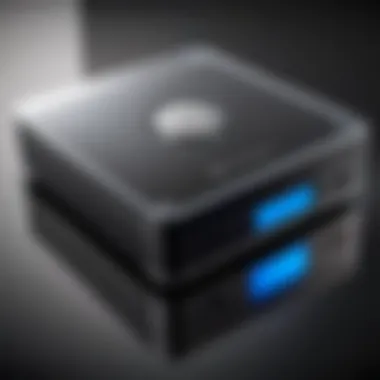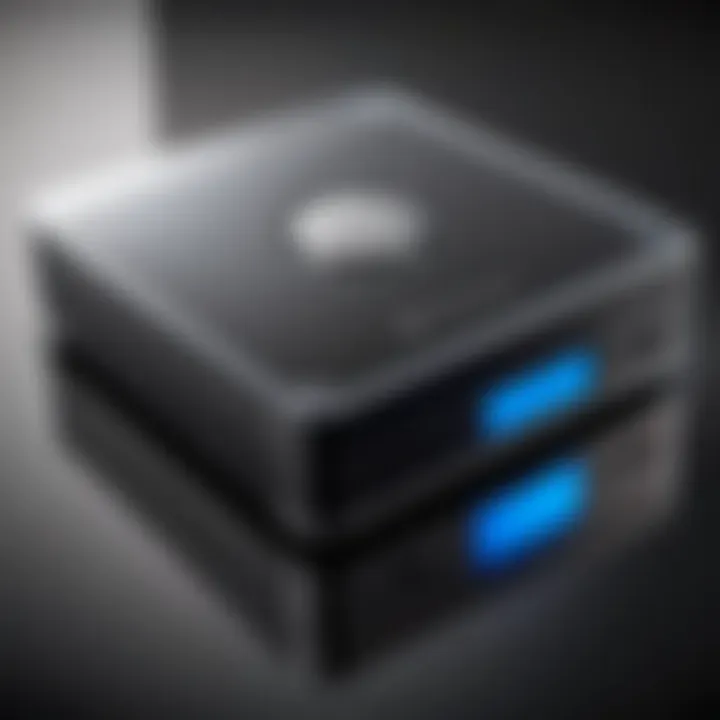Understanding External Writable CD Drives: Insights & Trends


Intro
External writable CD drives serve a distinct and vital role in today's technology landscape. Despite a noticeable shift towards digital media, these devices remain relevant for various users, including students, professionals, and casual tech enthusiasts. Understanding their functionalities, advantages, and market trends can guide potential buyers in making informed decisions.
Product Overview
When discussing external writable CD drives, it is essential to first understand what sets them apart from their internal counterparts. These devices connect through USB ports, allowing users to access and write data onto CDs without being confined to a specific PC.
Brand Information
Several brands excel in this market, notable among them are LG, ASUS, Samsung, and Pioneer. Each offers distinctive features tailored to different user preferences. For example, LG has a reputation for user-friendly designs while Pioneer focuses on high-performance devices.
Key Specifications
Key specifications might include:
- Interface: USB 3.0 or USB-C for faster data transfer.
- Write Speed: Typically ranges from 8x to 24x.
- Supported Formats: CD-R, CD-RW, DVD-R, and DVD+RW formats are standard.
Pricing
Pricing can vary widely based on the brand and specific features, generally falling in the range of $30 to $100. Higher-end models may approach or exceed $150, especially those targeting gamers or professional audio editing.
Performance Comparison
Performance remains a significant consideration when choosing an external writable CD drive. Comparative analysis of speed and efficiency can help potential buyers zero in on optimized products.
Benchmark Tests
Test results generally show that drives with USB 3.0 support perform noticeably better than those limited to USB 2.0. Write speeds might be assessed through multiple formats, ensuring users understand what to expect under various conditions.
Speed and Efficiency Comparisons
For example, when comparing drives:
- LG External Drive: Average write speed of 24x.
- ASUS External Drive: Average write speed of 16x.
Features and Technology
The landscape of external writable CD drives is shaped by continual technological advances that enhance their usability and performance.
Unique Features
Some standout features include:
- Disc Encryption: Added security measures for sensitive data.
- LightScribe Technology: Allows users to engrave labels onto discs.
Technological Advancements
Modern drives also boast improved error correction systems. This innovation ensures data integrity, allowing for smoother writing processes.
Compatibility with Other Devices
Most external CD drives are designed to be plug-and-play, making them compatible with various operating systems, including Windows, macOS, and certain Linux distributions. However, it is advisable to verify specific compatibility details before purchase.
Pros and Cons
Every device comes with strengths and potential areas for improvement that users should weigh carefully.
Strengths of the Product
- Portability: Easy to transport and store.
- Flexibility: Can be used with different computers and operating systems.
Areas for Improvement
- Durability: Some models may not withstand rough handling.
- Speed Limitations: Certain drives may have slower write speeds compared to internal drives.
Value for Money
Determining value for money extends beyond mere purchase price. Cost-effectiveness and long-term benefits are critical aspects to consider.
Cost-effectiveness
In many cases, the investment in a reliable external writable CD drive can save costs on storage solutions over time, as physical discs often offer greater longevity than temporary digital storage.
Long-term Benefits
The ability to create physical backups of essential data can greatly enhance data security. Additionally, the access to a broad range of formats makes these drives versatile for various uses.


Comparison with Similar Products
When pitted against flash drives or cloud storage, external CD drives offer a unique solution for those who require reliable physical mediums.
"In an age overwhelmed with digital solutions, the humble external writable CD drive remains a practical tool for data preservation."
Understanding these aspects can aid in making informed choices. As technology evolves, external writable CD drives continue to offer significant value.
Prelims to External Writable Drives
The realm of storage solutions continues to evolve rapidly, yet external writable CD drives maintain their relevance in both personal and professional contexts. Understanding these devices goes beyond mere specifications; it encompasses their historical importance and enduring utility. This section aims to clarify the significance of external writable CD drives, paving the way for more nuanced analysis of their technical specifications and practical applications.
Definition and Purpose
External writable CD drives are hardware devices used to read from and write data onto compact discs from an external connection, typically through USB. They serve various purposes, including data storage, media creation, and distribution. This unique aspect allows users to transfer digital content between devices, especially in scenarios where internal drives are absent, such as with ultrabooks or tablets.
Their primary purpose is to provide an accessible means of data management. They support various disk formats like CD-R, CD-RW, and even DVD options, making them versatile tools for both casual users and professionals. This flexibility caters to different requirements, ranging from archiving personal photographs to producing audio CDs.
Historical Context
Historically, the integration of optical drives into computers began in the late 1980s with the introduction of CD-ROM technology. External writable CD drives surfaced as a convenient solution to the limitations of internal drives. Over time, as digital storage methods advanced, the significance of these drives seemed to wane. Yet, they found a niche market among users who value tactile media and prefer physical storage.
Their history reflects the overall evolution of data management, illustrating shifts in technology and user preferences. As digital downloads and cloud storage emerged, external writable CD drives adapted by enhancing compatibility and speed. Notably, the adaptability of these devices illustrates their capacity to remain meaningful in an ever-changing landscape of technology.
"The charm of external writable CD drives lies in their ability to provide a tangible means of data management, a contrast to increasingly abstract digital solutions."
In summary, exploring the definition, purpose, and historical context of external writable CD drives establishes a foundational understanding. It highlights their functional role, historical significance, and continual relevance in the modern age. This investigation leads directly into a comprehensive analysis of their technical specifications, compatibility considerations, and market trends.
Technical Specifications
Technical specifications are crucial for understanding the performance and functionality of external writable CD drives. They encompass various attributes that influence user experience, including read and write capabilities, data transfer speeds, and connectivity options. Knowledge of these specifications enables users to make informed purchasing decisions based on their needs.
Read and Write Capabilities
The read and write capabilities define what types of discs a drive can manage. Most external writable CD drives are compatible with a range of formats, such as CD-R, CD-RW, DVD-R, and DVD+RW. The ability to write to different disc types is essential for users who need flexibility in storage options. For example, CD-R discs are often used for one-time data burning, while CD-RW discs allow for data reuse.
Adequate writing speed is also a consideration. Drives are categorized by how fast they can write data, typically measured in X speed. Therefore, understanding these speeds is necessary for tasks involving large files or multiple burns.
Data Transfer Speeds
Data transfer speeds refer to how quickly data can be read from or written to a disc. These speeds are essential for efficiency, especially when handling large volumes of data. If a drive's transfer speed is too slow, it could hinder productivity, causing delays in data management tasks.
Usually measured in KB/s or MB/s, faster drives considerably reduce the time needed to burn or access data. When looking for a drive, it is advisable to consider both burst speeds and sustained speeds, as they can vary during use.
Connectivity Options
The connectivity of external writable CD drives is a vital aspect of their compatibility with various devices.
USB Standards
USB standards play an essential role in establishing a connection between the drive and its host device. The most common standard is USB 2.0, but many modern drives now support USB 3.0 and even USB-C.
USB 3.0 offers significantly faster data transfer rates compared to its predecessor, making it a popular choice. It allows users to transfer data efficiently and is backwards compatible with USB 2.0 devices. However, devices need to support USB 3.0 to take advantage of these speeds.
One unique feature of USB connections is their plug-and-play capability, permitting easy and immediate use. On the downside, fewer ports on new laptops can limit connectivity options for some users.
Wireless Connectivity
Wireless connectivity is an emerging feature in external writable CD drives. This aspect allows drives to connect to devices without the need for physical cables, facilitating more versatile setups.
The key characteristic of wireless drives is their ability to operate over Wi-Fi or Bluetooth. This flexibility allows for convenient access to the drive from multiple devices, such as tablets or smartphones. Though beneficial, the primary disadvantage lies in the potential for slower transfer speeds and reliance on network stability for seamless operation.
Knowledge of technical specifications leads to informed decisions and optimized user experiences.
Compatibility Considerations
Compatibility is a crucial aspect when it comes to external writable CD drives. Ensuring that these devices work seamlessly with various systems is paramount for users. Without proper compatibility, even the most advanced drive could become functionally useless.
Operating Systems
Different operating systems have unique drivers and requirements for external writable CD drives. Windows, macOS, and Linux each handle these devices in specific ways. For instance, Windows might automatically recognize the drive, allowing for straightforward integration, while macOS can require additional software for full functionality.
This compatibility extends beyond the operating systems to include various versions. The introduction of new versions may come with enhancements that impact how these drives perform. Users with outdated OS versions may experience issues, such as slower data transfer rates or inability to use certain features. Furthermore, leaving Windows 7 for Windows 10 can significantly improve compatibility with modern drives, as the latter supports newer technologies more efficiently.
When considering an external writable CD drive, it is wise to check compatibility with the specific version of the operating system you plan to use it with. Some manufacturers provide lists of compatible systems, making these checks easier for potential buyers.
Device Integration


The ability of external writable CD drives to integrate with various devices impacts their overall utility. Many users want to use these drives with more than just their computers; they also desire compatibility with game consoles, multimedia players, and even older laptops that may lack internal drives. This versatility is essential in an age where digital media consumption varies widely.
Moreover, device integration can sometimes involve additional requirements. For example, some game consoles may only support specific file formats for data storage. Ensuring that the external drive can handle these formats will be an important consideration for gamers.
Connectivity options also play a role. A device with USB-C connectivity may not integrate easily with older systems that provide only USB-A ports. As technology evolves, ensuring that your external drive can connect to both legacy systems and newer hardware enhances its value significantly.
In summary, compatibility considerations extend beyond mere connectivity; they also involve understanding the ecosystem in which the drive will operate. Through careful evaluation of operating systems and potential device integration scenarios, consumers can make informed decisions and avoid frustration in their technological experience.
Market Trends and Innovations
The significance of market trends and innovations in the realm of external writable CD drives cannot be overstated. As technology evolves, so do the needs of consumers. The analysis of both the current market landscape and the emerging technologies provides crucial insights for users seeking to make informed purchasing decisions. These factors greatly influence performance, usability, and longevity of the devices.
Current Market Landscape
The current market for external writable CD drives is characterized by a mix of established products and new entrants. Demand has shifted as users look for versatile devices that can handle multiple formats, not just CDs. Many brands are focusing on enhancing the user experience by improving design, durability, and speed. Market players like LG, ASUS, and Pioneer are competing fiercely. They offer a range of options suitable for different user needs, from casual usage to professional applications. The growing emphasis on portability is also evident, with many consumers opting for lightweight drives that can easily connect to various devices.
Emerging Technologies
Cloud Integration
Cloud integration has emerged as a notable trend in the digital storage space. This technology allows users to back up data online, which reflects a shift in how data is managed compared to traditional physical methods. One of the key characteristics of cloud integration is its accessibility; users can reach their files from multiple devices at any time. This flexibility makes it a popular choice for tech-savvy individuals.
However, there can be drawbacks, such as concerns about security and reliance on internet connectivity. The unique feature of cloud storage is its capacity to scale according to user needs, yet it can often leave users anxious about data privacy and control.
"Cloud integration offers unparalleled convenience, but users must remain vigilant about security risks."
Solid State Media Alternatives
Solid state media alternatives present another shift in this space. Unlike traditional CD drives, these devices utilize flash storage technology. One of their key characteristics is speed. Solid state drives (SSDs) significantly reduce load times compared to standard external writable CD drives. Thus, they are increasingly chosen by those requiring quick access to large files.
A notable unique feature of solid state media is their resilience to physical damage. They contain no moving parts, making them less susceptible to failure due to shock or vibration. However, the higher cost and lower storage capacity compared to traditional CDs can be seen as disadvantages. Users may find it beneficial to weigh these pros and cons carefully when deciding between formats.
In summary, keeping track of these market trends and innovations is essential. They inform the user about what options are available and help evaluate the functionality needed for various applications, establishing a foundation for future developments in external writable CD drives.
Practical Applications
Practical applications of external writable CD drives play a critical role in understanding their significance in modern technology. These devices are not just relics of a bygone era; they serve specific functions that remain relevant in various fields. The practical aspects can be broadly categorized into data storage and backup solutions, and media creation and distribution. Each of these categories addresses unique user needs and preferences, highlighting the ongoing utility of external writable CD drives.
Data Storage and Backup Solutions
External writable CD drives provide an efficient means for data storage and backups. In an age where data loss can be detrimental, these drives offer a reliable way to safeguard important files. By allowing users to easily copy and save data to CDs, they provide a tangible backup solution for critical information. For tech enthusiasts and IT professionals, the ability to archive data on physical media is vital, particularly when dealing with sensitive information or large volumes of data.
Here are some key benefits of using external writable CD drives for data storage:
- Cost-Effectiveness: CD media is generally less expensive compared to other storage methods like external hard drives or cloud solutions.
- Portability: CDs are lightweight and easy to transport, making them convenient for moving data between locations.
- Longevity: With proper storage, CDs can last for many years, providing a reliable long-term storage solution.
- Compatibility: CDs can often be read on various devices, ensuring access even without specific software.
With data security being a top priority, the reliability of external writable CD drives is particularly appealing. They allow for physical control over backups, which can be a significant advantage in preventing data loss due to online vulnerabilities.
Media Creation and Distribution
Beyond storage, external writable CD drives are essential for media creation and distribution. For creators, these drives offer a practical way to physically distribute their work, whether it is music, educational materials, or proprietary software. Artists and professionals often need to produce physical copies for presentations, sales, or personal distribution. With these drives, the task becomes straightforward.
Considerations for media creation and distribution include:
- Customized Labels: Users can create personalized labels for their CDs, enhancing their presentation and professional appearance. This is particularly important in creative fields where branding matters.
- Batch Production: External writable CD drives allow for the efficient production of multiple copies, facilitating the needs of businesses and creators that require several distributions of content.
- Ease of Use: Many CD drives come with user-friendly software that simplifies the process of burning and formatting CDs, making it accessible even for those with limited technical skills.
"External writable CD drives continue to offer tangible benefits, maintaining their place in a digital landscape dominated by cloud solutions and solid-state drives."
Understanding these applications helps to clarify their role in the tech ecosystem and guides informed decision-making about their use.
Consumer Preferences and Buying Considerations
When it comes to selecting an external writable CD drive, understanding consumer preferences and various buying considerations is essential. These factors play a pivotal role in determining which product best suits an individual's or an organization's needs. As the market evolves with newer technologies, consumers are increasingly scrutinizing their choices and demanding more from their purchases.
In this framework, two critical aspects stand out: brand reputation and the price-to-performance ratio. These elements significantly influence consumer buying behavior and can delineate the quality of their investment. A clear focus on these topics aids potential buyers in making educated decisions.
Brand Reputation
Brand reputation emerges as a prominent factor in the purchasing journey. Established brands often command trust among consumers, as they are associated with reliability and quality. In the context of external writable CD drives, a brand like LG or ASUS, for example, has built a pedigree over time. Consumers recognize that these brands consistently deliver products that meet or exceed expectations.
Moreover, brand reputation is not merely a reflection of the product's performance but also encompasses customer service and support. Buyers often look at reviews and ratings from past customers to gauge the performance of a drive. These testimonials illuminate the reliability of a brand, especially if the drive encounters issues down the line.
Another dimension to brand reputation is innovation. Companies that invest in technology and continuously improve their products are more likely to attract discerning buyers. Users are inclined to select brands that not only provide what they need now but also display a commitment to future-proofing their devices through software updates and new features.
Price to Performance Ratio
The price-to-performance ratio is a critical metric for tech-savvy consumers. This ratio essentially measures what customers receive concerning the cost they incur. In a flooded market of external writable CD drives, buyers often seek to maximize their investment. When comparing products, aspects such as speed, durability, and compatibility become fundamental to this evaluation.


For example, if the Pioneer BDR-XD07B offers better speed and features when compared to similarly priced models, it becomes more appealing. Consumers need to weigh how performance aligns with their specific needs—be it for professional media creation or simple data backup.
It’s also worth noting that the cheapest option may not always offer the best value. In some cases, opting for a slightly more expensive drive that guarantees superior performance or added functionalities can save time and frustrations in the long run. Therefore, consumers must analyze this ratio thoroughly, ensuring that their choice provides the best value and fulfills their requirements.
"A careful understanding of brand reputation and price-to-performance ratio leads to not merely a purchase, but an investment in quality and usability."
Review of Top External Writable Drives
Examining the leading external writable CD drives is crucial in understanding their relevance in today's tech landscape. These devices play a significant role in data storage, media production, and seamless data transfer. As technology continues to evolve, consumer preferences have also changed, making it necessary to evaluate the top products available. This section aims to provide insights into particular CD drives, facilitating informed decisions for tech enthusiasts, gamers, and IT professionals.
Product A Overview
Specifications
The specifications of Product A highlight its read and write capabilities, supporting various CD formats including CD-RW and CD-R. This flexibility allows for compatibility with different media types, making it a preferred choice among users. One notable feature is the drive's support for high-speed burning technology, which significantly reduces the time required to write data onto CDs. Such a feature enhances productivity and effectively meets users’ demands for efficient media handling.
Pros and Cons
The pros of Product A include its high-speed writing ability and broad compatibility with multiple formats. This enables users to create and read a variety of discs without significant limitations. However, a downside might be its price point, which is slightly higher than some competing models. Users need to weigh these pros and cons according to their specific needs and budgets.
Product B Overview
Specifications
Product B boasts a robust set of specifications, particularly focusing on its data transfer speeds. Featuring USB 3.0 connectivity, the device ensures rapid data transfer, making it ideal for large file movements or backups. Additionally, the drive is equipped with buffer underrun protection, which prevents data loss during burning processes, thereby enhancing reliability. This aspect is critical, especially for professionals who require unblemished results in their media creations.
Pros and Cons
The advantages of Product B include its reliable performance and enhanced data transfer speeds. Users find these attributes particularly useful while working with large files. Conversely, the product's somewhat heavier build could deter users who prefer lightweight solutions for portability. Examining these qualities allows consumers to assess whether Product B fits their lifestyle and work habits.
Product Overview
Specifications
Product C is distinguished by its versatility in format compatibility. It not only supports CD formats but also enables DVD writing, which expands its utility for those needing comprehensive media files. The drive features a compact design that enhances portability while still providing solid performance levels. This unique combination appeals to users who prioritize convenience without sacrificing functionality.
Pros and Cons
With Product C, the primary advantage is its multifunctionality, allowing for both CD and DVD writing capabilities. This flexibility makes it appealing for varied use cases, from backups to media distribution. However, the downside includes a slightly slower write speed compared to Product A, which may be a consideration for those prioritizing speed over versatility. Analyzing these traits is essential for discerning buyers looking for tailored solutions to their specific tasks.
Maintenance and Troubleshooting
In any technology, maintenance and troubleshooting play critical roles in ensuring longevity and optimal performance. External writable CD drives, while robust, are not immune to issues that could affect their functionality. A thorough understanding of maintenance practices and common troubleshooting techniques can greatly enhance user experience and prevent costly replacements.
Regular maintenance is vital as it helps in identifying potential problems before they escalate. Furthermore, users who invest time in maintenance will often experience better performance and reliability from their devices. This portion of the article addresses specific common issues users may encounter with their external writable CD drives, as well as best practices for ensuring they function efficiently over time.
Common Issues and Solutions
There are several common issues that can arise when using external writable CD drives. Users must be aware of these problems to resolve them swiftly. Some of the frequent issues include:
- Drive Not Recognized: Sometimes, the computer might fail to detect the external CD drive. This can happen due to connectivity problems or driver issues. To remedy this, ensure that the USB connection is secure. Be sure to check device management settings to see if drivers need updating.
- Writing Errors: These errors occur during the burning process. The main reasons could be incompatible media or software conflicts. To solve this, consider using quality discs such as Verbatim or TDK and ensure the burning software is up-to-date.
- Physical Damage: External drives are particularly susceptible to physical damages like dents or scratches. Protect your device by using a proper case. If the drive is compromised, it may need replacement.
- Slow Performance: Slow read/write speeds can be frustrating. This can be caused by fragmented files or a nearly full drive. Regularly defragment your computer’s hard disk and maintain adequate free space on your CD drive.
"Regular maintenance will extend the lifespan of your external writable CD drive, saving you time and expense in the long run."
Best Practices for Longevity
Adopting best practices can have a remarkable impact on the performance and lifespan of external writable CD drives. Consider the following strategies:
- Proper Storage: When not in use, store your external CD drive in a cool, dry place. Avoid locations with extreme temperatures or humidity, which might damage the internal components.
- Cautious Handling: Handle the device with care. Avoid dropping or shaking it, especially when it is in operation, as this can damage the internal mechanisms.
- Regular Updates: Keep your computer's operating system and associated drivers updated. This will optimize performance and compatibility with other devices.
- Use Quality Media: Not all CD media is the same. Using higher-quality discs can lead to fewer errors and better data integrity. Brands like Sony are known for their reliability in this regard.
- Routine Checks: Schedule regular check-ups for your hardware. This may include cleaning the laser lens with a soft brush or cleaning disc, which can improve reading accuracy and reliability.
By being attentive to maintenance and troubleshooting, users can fully enjoy the benefits of their external writable CD drives. Keeping a proactive stance can prevent many problems, ensuring that these devices remain valuable tools in a digital landscape.
Future of External Writable Drives
The future of external writable CD drives merits examination as technological advancements continue to influence storage options. These devices may seem outdated in a digital world, yet they possess unique advantages that sustain their relevance. As users prioritize data preservation, understanding future trends can guide potential buyers in selecting the right tools for their needs.
Potential Developments
As we look ahead, several developments could shape the landscape of external writable CD drives:
- Increased Storage Capacity: Future iterations might enhance storage capabilities, allowing for higher data volumes. Manufacturers may explore innovative disc shapes or improved materials to achieve this.
- Enhanced Write Speeds: The speed at which data is written remains crucial to user satisfaction. Ongoing research may lead to technologies that significantly enhance writing efficiency.
- Improved Compatibility: Compatibility with a wider range of devices is essential. Future products may incorporate better support for various operating systems and platforms, ensuring seamless operation across devices.
- Integration with Cloud Services: The merging of physical and cloud storage could be a significant trend. This can allow users to back up data directly to the cloud while utilizing CD drives for local storage.
These trends indicate that while digital storage is dominant, the external writable CD drives will continue evolving to meet user needs.
Market Sustainability
Market sustainability for external writable CD drives depends on several factors:
- Consumer Demand: Even as cloud services grow, there remains a niche market for physical media in certain industries such as media production and archival work. Demand continues to influence product availability.
- Adaptation to New Technologies: Manufacturers who adapt their products to integrate emerging technologies, like USB-C connectivity or wireless options, will likely stay competitive.
- Environmental Considerations: With increasing focus on sustainability, creating eco-friendly drives could attract environmentally-conscious consumers.
- Competitive Pricing: As market players innovate, maintaining a favorable price-to-performance ratio will be essential in sustaining consumer interest.
Overall, the future of external writable CD drives relies on their ability to evolve and adapt while retaining the core advantages they offer to users.
"The ongoing demand for reliable data storage solutions indicates that external writable CD drives still hold significant value in various applications."
In summary, while the digital age has transformed storage habits, external writable CD drives remain pertinent. Their future hinges on advancements in technology, market demands, and user preferences.







